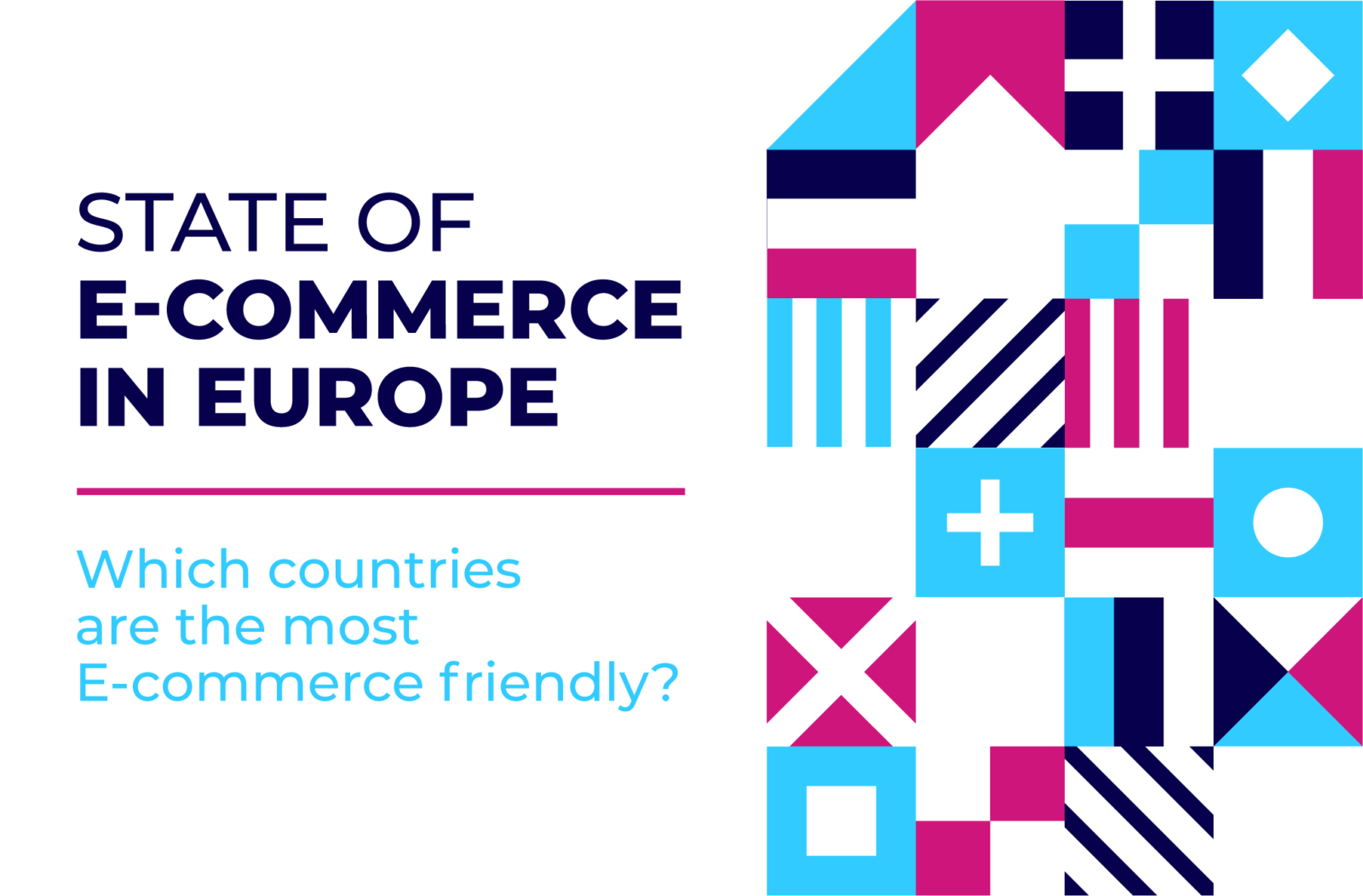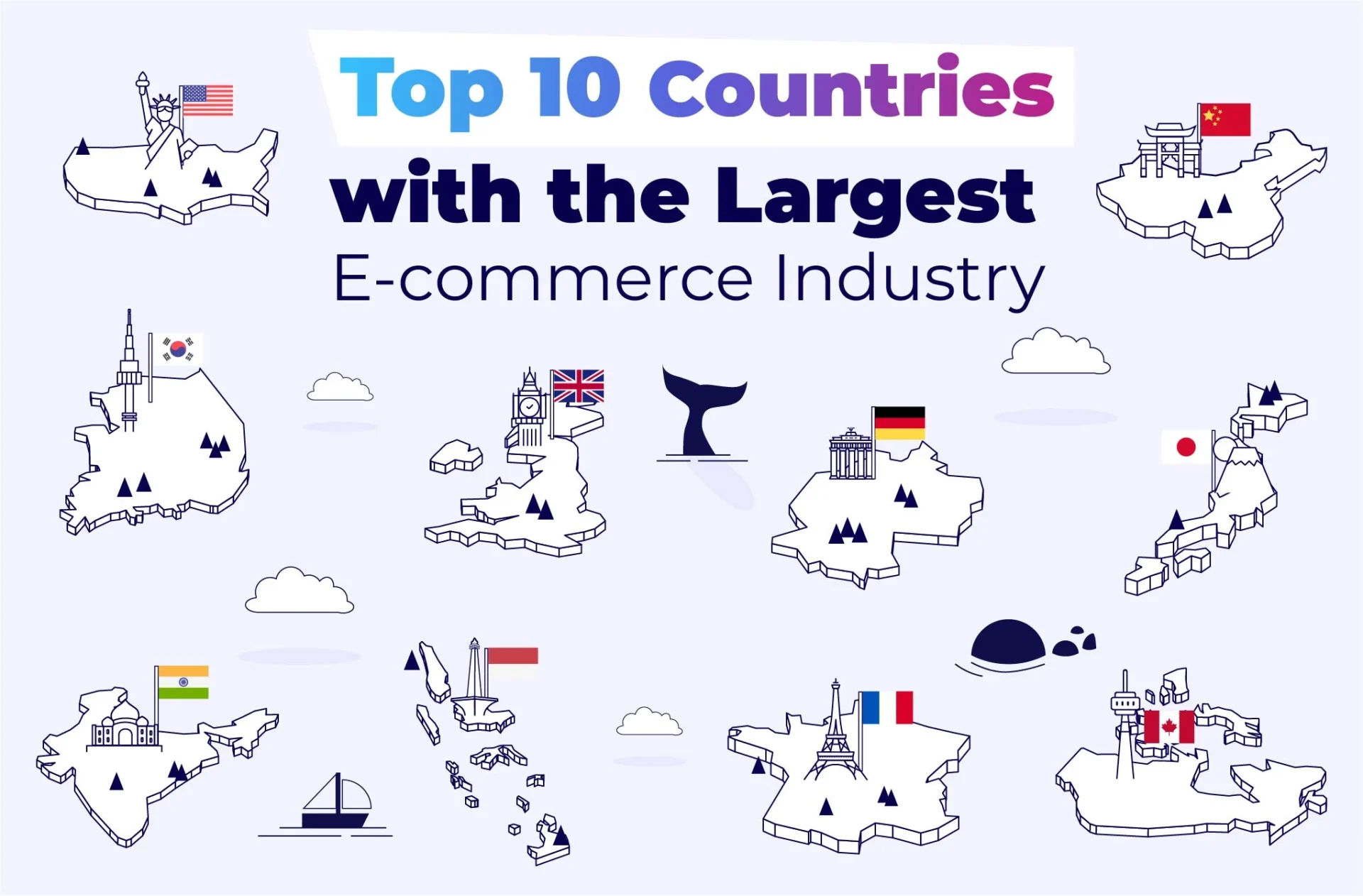E-commerce takes an increasingly important place in the lives of consumers, both globally and in Europe. This is mainly due to the large proportion of inhabitants of the economic area present on the Internet. Indeed, the Internet penetration rate is 89% in 2021, for 735.23 million inhabitants.
The E-commerce turnover is constantly increasing, year after year, to reach 18.333 billion euros in 2021. The craze is such that it is estimated that 73% of Europeans consume on the Internet.
To better understand the development of this method of online consumption, we will analyze its scope in different areas of Europe, based on the European E-Commerce Report of 2021.
You can also discover information about the various E-commerce markets in the world:
General stats about the European E-commerce market
The Internet has gained in popularity among Europeans. Between 2017, we could observe an increase of 7.28% in the number of users (89% in 2021 against 83.2% in 2017). This logically serves the E-commerce industry.
The average GDP of European countries has increased by 7.36% from 3.43 billion euros to 3.67 billion. The E-GDP (E-commerce share of GDP) has increased from 2.39% to 3.94%, representing an increase of 78.84%. This can be explained in particular by easier access to a fast Internet connection, as well as the democratization of smartphones, the development of 5G, …
Because of this, the share of average E-shoppers in Europe rose from 58.8% in 2017 to 71.4% in 2021. These consumers are used to digital processes and are notably present on social networks, gaining new users every year all over the world. The distribution of social networks in Europe is as follows (by number of users):
- Facebook : 93%
- Instagram : 77%
- Youtube: 66%
- Twitter: 42%
- Pinterest: 20%
- LinkedIn: 19%
- Tik Tok: 2%
- Snapchat: 1%
In order to get more information about the success of E-commerce in the European market, we will present you with different statistics per area:
- Western
- Northern
- Central
- Eastern
- Southern
The understanding of E-commerce markets is done through objective rating criteria, designated by :
- Logistics Performance Index: established in 2018 in this study, an index measuring the performance of the logistics supply chain in a country
- E-government Development Index: established in 2020 in this study, an index measuring the ability of a state to use new technologies in the provision of public services
- Inclusive Internet Index: established in 2021 in this study, this index measures the accessibility to the Internet by taking into account the price, the deployment of services, …
- Universal Postal Union Reliability Score: established in 2020 in this study, comparative index comparing the performance of postal services to global performance
- UNCTAD B2C E-commerce Index Ranking: established in 2020 in this study, index measuring the capacity of a market to support E-commerce
- Environmental Performance Index: established in 2020 in this study, an index measuring the environmental health and ecosystem vitality of various countries by taking into account various statistics
- Global Cybersecurity Index: established in 2020 in this study, index measuring the ability of a country to ensure cybersecurity, taking into account 5 pillars
- Ease of doing Business Index: established in 2020, the ability of traders to open their business and promote their products to consumers
Here is an example of an index taken into account:

E-Commerce in Western Europe
The Western Europe area includes 7 countries in total, which are :
- United Kingdom
- France
- Luxembourg
- Germany
- Netherlands
- Belgium
- Ireland
| Country | Logistics Performance Index (2018) | Ease of Doing Business Index (2020) | E-Government DevelopmentIndex (2020) | Inclusive Internet Index (2021) | Universal Postal UnionReliability Score (2020) | UNCTAD B2C E-commerceIndex Ranking (2020) | Environmental PerformanceIndex Ranking (2020) | Global Cybersecurity IndexRanking (2020) | Average |
| United Kingdom | 9 | 8 | 7 | 9 | 8 | 5 | 4 | 2 | 6,50 |
| Germany | 1 | 22 | 25 | 25 | 3 | 6 | 10 | 13 | 13,13 |
| Netherlands | 6 | 42 | 10 | 16 | 4 | 2 | 11 | 16 | 13,38 |
| France | 16 | 32 | 19 | 6 | 6 | 17 | 9 | 5 | 13,75 |
| Belgium | 3 | 46 | 41 | 21 | 12 | 21 | 15 | 19 | 22,25 |
| Ireland | 29 | 24 | 27 | 23 | 15 | 8 | 16 | 46 | 23,50 |
| Luxembourg | 24 | 72 | 33 | – | 71 | 36 | 2 | 13 | 35,86 |
Overall, the best performing country in this part of Europe is the United Kingdom. Despite the fact that its divorce from the European Union in the form of Brexit is a current issue, the country is very favorable to online consumption.
The reason: 99% of British people are connected, and 93% of them regularly consume on the Internet. This leads E-commerce to represent more than 10% of the country’s GDP, amounting to €2,478 billion in 2020. Taking into account all the indices presented above, the United Kingdom obtains an average index of 6.5.
In second place in this zone is Germany, another world power that has a flourishing digital market with the development of major online stores in Europe.
Germany performs particularly well on logistics issues, with an index of 1. This is due in part to the country’s efforts to invest in R&D to streamline logistics processes and help employment. Regarding e-commerce as a whole, 96% of the German population is connected to the Internet, with 88% of regular online consumers. Online sales represent 3.24% of a GDP amounting to €3,083 billion, the highest in Western Europe. The average index presented for Germany is 13.13.
In 3rd place of this ranking in Western Europe, we can find the Netherlands, between Germany (13.13 average) and France (13.75 average), at a few points.
The country is particularly strong in terms of accessibility to e-commerce thanks to the efforts of the market. Indeed, the index for this issue is 2 for the Netherlands. Digital is particularly developed, since 95% of the population regularly uses the Internet, and 93% regularly buys online. Online sales are then expected to represent 3.57% of a GDP of €781 billion. The average index presented for the Netherlands is 13.38.
E-Commerce in Northern Europe
The Northern Europe area includes 8 countries in total, which are :
- Estonia
- Lithuania
- Latvia
- Norway
- Finland
- Sweden
- Denmark
- Iceland
| Country | Logistics Performance Index (2018) | Ease of Doing Business Index (2020) | E-Government DevelopmentIndex (2020) | Inclusive Internet Index (2021) | Universal Postal UnionReliability Score (2020) | UNCTAD B2C E-commerceIndex Ranking (2020) | Environmental PerformanceIndex Ranking (2020) | Global Cybersecurity IndexRanking (2020) | Average |
| Sweden | 2 | 10 | 6 | 1 | 24 | 15 | 8 | 26 | 11,5 |
| Denmark | 8 | 4 | 1 | 9 | 53 | 3 | 1 | 32 | 13,875 |
| Finland | 10 | 20 | 4 | 18 | 28 | 7 | 7 | 22 | 14,5 |
| Norway | 21 | 9 | 13 | – | 34 | 9 | 9 | 17 | 16 |
| Estonia | 36 | 18 | 3 | 30 | 25 | 14 | 30 | 3 | 19,875 |
| Lithuania | 54 | 11 | 20 | 17 | 31 | 27 | 35 | 6 | 25,125 |
| Iceland | 40 | 26 | 12 | – | 79 | 32 | 17 | 58 | 37,71428571 |
| Latvia | 70 | 19 | 49 | 32 | 62 | 39 | 36 | 15 | 40,25 |
Sweden is the most performing E-commerce market in this European zone, offering easy access to the Internet to its population as well as a very efficient logistic capacity.
A large majority of Swedes are connected to the Internet: 97%. They naturally turn to online consumption (for 87% of them), which represents 2.6% of total GDP, amounting to €491 billion. Sweden obtains an average index of 11.5.
In second position in Northern Europe, we find Denmark, offering a great adaptability to the new means of online consumption and this, in respect of the environment. In both categories, the country obtains an index of 1, which makes it one of the countries with the best performing e-commerce market in Europe.
Almost the entire population is connected to the Internet (99%), which means that a majority, 91%, of the population turns to online sales. E-commerce represents 7.83% of the country’s GDP, amounting to €290 billion.
Then comes Finland, once again showing its ability to provide E-commerce services to its population, itself very receptive to this method of consumption.
We find, for this country too, a large part of the population connected to the Internet (97%). In spite of this great connectivity, only 79% of the consumers are oriented towards online purchases. Nevertheless, this does not prevent e-commerce from representing 2.76% of Finland’s GDP, which amounts to €211 billion.
E-Commerce in Central Europe
The Northern Europe area includes 7 countries in total, which are :
- Austria
- Czechia
- Hungary
- Poland
- Slovak Republic
- Slovenia
- Switzerland
| Country | Logistics Performance Index (2018) | Ease of Doing Business Index (2020) | E-Government DevelopmentIndex (2020) | Inclusive Internet Index (2021) | Universal Postal UnionReliability Score (2020) | UNCTAD B2C E-commerceIndex Ranking (2020) | Environmental PerformanceIndex Ranking (2020) | Global Cybersecurity IndexRanking (2020) | Average |
| Austria | 4 | 27 | 15 | 27 | 2 | 19 | 6 | 29 | 16,13 |
| Switzerland | 13 | 36 | 16 | 20 | 1 | 1 | 3 | 42 | 16,50 |
| Poland | 23 | 40 | 24 | 12 | 13 | 28 | 37 | 30 | 25,88 |
| Czech Republic | 22 | 41 | 39 | 31 | 16 | 22 | 20 | 68 | 32,38 |
| Slovak Republic | 53 | 45 | 48 | 34 | 21 | 23 | 26 | 34 | 35,50 |
| Slovenia | 35 | 37 | 23 | – | 40 | 34 | 18 | 67 | 36,29 |
| Hungary | 31 | 52 | 52 | 40 | 32 | 31 | 33 | 35 | 38,25 |
In the first position of this part on Central Europe, we find Austria, particularly efficient concerning its logistic infrastructures as well as its postal services.
Despite a high adoption of the Internet in the country, with 90% of the population, it has not yet taken advantage of e-commerce and its offers, with only 73% of e-shoppers. Despite this, the e-GDP still represents 2.72% of Austria’s total GDP, which amounts to €353billion. Austria obtains an average index of 16.13
In 2nd position by a very small margin, Switzerland is one of the smallest markets present in this zone, representing however a great opportunity for E-traders wishing to propose their products in this country.
The population is largely (97%) present on the Internet, and consumes on this distribution channel (93%). Despite the size of this market and the number of consumers present, it presents a GDP of €672billion, with E-commerce representing 1.94%. The average index for Switzerland is 16.5.
Almost 10 points behind Switzerland, Poland is the 3rd country with the best index in Central Europe.
87% of the Polish population uses the Internet, and 74% of them consume on the Internet. This may not seem like much, but e-commerce represents 5.73% of the country’s total GDP, amounting to €461 billion. The average index of Poland is 25.88.
E-Commerce in Eastern Europe
The Eastern Europe area includes 8 countries in total, which are :
- Russia
- Croatia
- North Macedonia
- Serbia
- Romania
- Moldova
- Bulgaria
- Ukraine
| Country | Logistics Performance Index (2018) | Ease of Doing Business Index (2020) | E-Government DevelopmentIndex (2020) | Inclusive Internet Index (2021) | Universal Postal UnionReliability Score (2020) | UNCTAD B2C E-commerceIndex Ranking (2020) | Environmental PerformanceIndex Ranking (2020) | Global Cybersecurity IndexRanking (2020) | Average |
| Russia | 75 | 28 | 36 | 25 | 19 | 41 | 58 | 5 | 35,88 |
| Croatia | 49 | 51 | 39 | 53 | 33 | 25 | 34 | 33 | 39,63 |
| Serbia | 65 | 44 | 58 | – | 29 | 43 | 45 | 39 | 46,14 |
| Romania | 48 | 55 | 55 | 29 | 44 | 45 | 32 | 62 | 46,25 |
| Bulgaria | 52 | 61 | 44 | 37 | 43 | 46 | 41 | 77 | 50,13 |
| North Macedonia | 81 | 17 | 72 | – | 51 | 52 | 43 | 38 | 50,57 |
| Ukraine | 66 | 64 | 69 | 48 | 30 | 51 | 60 | 78 | 58,25 |
| Moldova | 116 | 48 | 79 | – | 26 | 53 | 87 | 63 | 67,43 |
Russia, one of the world’s largest powers, is a complicated playing field for new business entrants. The country is particularly marked by a particular geography: the territory is very vast and specific, with a large area of emptiness. This does not facilitate logistical processes, as evidenced by the LPI of 75.
Russia is one of the only countries where Internet usage has decreased in recent years, from 83% of the population in 2019 to 81% in 2021. This has not stopped the share of e-shoppers from increasing from 41% to 45% over these two years. Finally, the E-GDP accounts for 2.59% of the country’s total GDP share of €1.641 billion. The average index for Russia is 35.88.
After Russia, we find Croatia, 65th E-commerce market in the world. It is one of the countries of Eastern Europe where online commerce is the most developed, especially since the pandemic of COVID-19.
In Croatia, 81% of the population uses the Internet, and 75% of them buy regularly online. Despite this, the E-GDP occupies only 1.47% of the global GDP amounting to €51.1 billion. Croatia’s average index is 39.63.
Serbia is a market with great potential for online sales professionals. Indeed, E-commerce is taking a more and more important place in the market and in the life of consumers in the country.
80% of Serbians regularly use the Internet. Despite the growth of e-commerce, only 51% of consumers buy online. This means that there is a strong potential for growth. At the moment, online sales represent only 1.17% of GDP, which amounts to €35.9 billion. The average index of the country is 46.14.
E-Commerce in Southern Europe
The Southern Europe area includes 7 countries in total, which are :
- Spain
- Italy
- Portugal
- Cyprus
- Greece
- Malta
- Albania
| Country | Logistics Performance Index (2018) | Ease of Doing Business Index (2020) | E-Government DevelopmentIndex (2020) | Inclusive Internet Index (2021) | Universal Postal UnionReliability Score (2020) | UNCTAD B2C E-commerceIndex Ranking (2020) | Environmental PerformanceIndex Ranking (2020) | Global Cybersecurity IndexRanking (2020) | Average |
| Spain | 17 | 30 | 17 | 3 | 37 | 24 | 14 | 4 | 18,25 |
| Italy | 19 | 58 | 37 | 14 | 11 | 29 | 20 | 20 | 26,00 |
| Portugal | 23 | 39 | 35 | 33 | 22 | 40 | 27 | 14 | 29,13 |
| Cyprus | 45 | 54 | 18 | – | 39 | 38 | 31 | 41 | 38,00 |
| Greece | 42 | 79 | 42 | 38 | 38 | 33 | 25 | 28 | 40,63 |
| Malta | 69 | 88 | 22 | – | 59 | 48 | 23 | 49 | 51,14 |
| Albania | 88 | 82 | 59 | – | 95 | 86 | 62 | 80 | 78,86 |
Spain has been particularly affected by the global financial crisis that took place in 2007-2008, and then by the pandemic of COVID-19. However, this has not prevented e-commerce from developing and consumers from adopting this means of consumption.
In all, 94% of the Spanish population uses the Internet, and 70% consume regularly online in 2021, representing an increase of 32.08% compared to 2015 (while the rate of Internet users has increased by 17.5%). This shows, among other things, that consumers in the market are more inclined to buy their products and services on the Internet. E-commerce accounts for a large share of the country’s GDP, 6.64% out of a total of €1,237 billion. The average index for Spain is 18.25.
In second place on this short list of Southern European countries is Italy. The country stands out particularly for the performance of its postal services.
Despite a relatively low Internet usage rate (83%) and a limited number of e-shoppers (59%), the E-GDP amounts to 2.35% of the €1,640 billion total. The average index presented by Italy is 26.
Finally, we find Portugal, with one of the best cybersecurity indices in the Southern Europe zone, behind Spain.
81% of the Portuguese regularly use the Internet, and 60% of them buy online. E-commerce occupies an important part of the GDP, with 4.43% out of €192 billion. The average index for Portugal is 29.13.
Infographic: E-commerce in Europe






